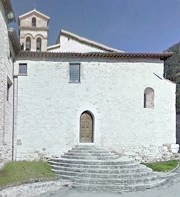


Ex-church of Sant’ Andrea
The church of Sant’ Andrea was built on the site of Roman building, perhaps a temple, signs of which have been found under its apse. It gave its name to this part of the city from ca. 1200 and was first documented in its own right in 1295.
San Marziale
In 1365, Bishop Giovanni Morlaco gave permission to Vagnarello di Barile to establish the Benedictine nunnery of San Marziale on his land adjoining Sant’ Andrea. Pope Clement VII authorised the transfer of the church of Sant’ Andrea to the nuns of San Marziale in 1528. In 1646, Cardinal Marzio Giannetti gave the nuns the relics of St Victoria, which had been found in the catacomb of Sant’ Agnese, Rome, and they were duly translated to their nunnery. Bishop Alessandro Sperelli, who recognised the relics on their arrival, performed their translation to a new altar in the nuns’ church in 1653. (This altar was destroyed during the restoration of the church in 1967-8.
Santa Chiara
In 1378, a community of Poor Clares that had been established in Gubbio since 1254 acquired another plot of land here from the Abbazia di San Pietro and built a new nunnery, the Monastero di Santa Chiara. The construction of a second church (Chiesa Nuova) is documented in 1473. (These churches, in Via XX Settembre and Via Appennino, were subsequently adapted for residential use).
Merger and Suppression
In 1787, both communities were suppressed. The nuns were allowed to stay in their respective nunneries, but they were not allowed to accept new entrants and they were deprived of most of their property. The few remaining nuns were then merged into a single community, and their nunnery became known as the Monastero di Santa Maria del Carmine.
This community suffered suppression in 1808-14 and again in 1860, although once more the existing nuns were allowed to remain in the ex-nunnery. They managed to buy it in 1903. Part of the complex in Via XX Settembre and Via Appennino was adapted for residential use in 1971-2. Much of the remaining part of the complex in Via Sant’ Antonio and Via Colomboni was damaged in a serious fire in 1972. The nunnery finally closed in 1989.
The church and a small part of the nunnery were recently acquired by a female confraternity known as the Sorelle del Piccolo Testamento di San Francesco. The rest of the complex has recently been adapted for residential use.
Church
Part of the exterior of the 11th church survives, including the semi-circular apse, which (as mentioned above) seems to have been built using material from a pre-existing Roman structure. Its facade was demolished in 1761 to make way for a new choir. A semicircular flight of stairs in the right wall now leads to the entrance.
As noted above, the church was restored in 1967-8.
The original barrel-vaulted nave communicates with a vaulted aisle to the left of it, which was added in 1528 when the church became part of the adjacent nunnery.
Art from the Complex
All three of the following works were recorded during a pastoral visit in 1696. The first two are now in the choir and the third was (at least until recently) in the nunnery
Madonna and Child with saints (1553)
This altarpiece from the high altar is signed by Benedetto Nucci and dated by inscription. It depicts the Madonna and Child enthroned with the young St John the Baptist. SS Andrew and Martial stand to the sides and two angels hold a crown above the head of the Madonna.
St Victoria (ca. 1653)
This altarpiece was commissioned from Giovanni Battista Michelini, il Folignate to mark the translation of the relics of St Victoria to the church in 1653 (see above).
Madonna and Child with saints (ca. 1610)
This altarpiece, which depicts the Madonna and Child enthroned with six saints, is attributed to Virgilio Nucci. The saints can be identified as: SS Francis; Antony of Padua; Euphemia, Mary Magdalene; Elizabeth of Hungary; and Apollonia. The presence of the Franciscan saints suggests that it almost certainly came from Santa Chiara.
Read more:
The website of ARCHITETTO MARCO PETRINI provides comprehensive information on the history of the complex and its current adaptation for residential use.
Return to Nunneries of Gubbio.
Return to Monuments of Gubbio.
Return to Walk I.

